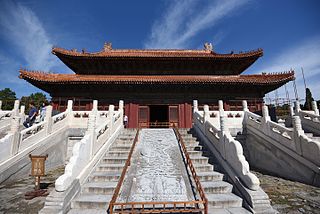
Tangshan is a coastal, industrial prefecture-level city in the northeast of Hebei province. It is located in the eastern part of Hebei Province and the northeastern part of the North China Plain. It is located in the central area of the Bohai Rim and serves as the main traffic corridor to the Northeast. The city faces the Bohai Sea in the south, the Yan Mountains in the north, Qinhuangdao across the Luan River to the east, and Tianjin to the west.
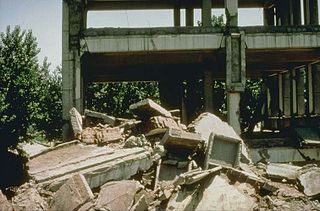
The 1976 Tangshan earthquake was a 7.6 earthquake that hit the region around Tangshan, Hebei, China, at 3:42 a.m. on 28 July 1976. The maximum intensity of the earthquake was XI (Extreme) on the Mercalli scale. In minutes, 85 percent of the buildings in Tangshan collapsed or were rendered unusable, all services failed, and most of the highway and railway bridges collapsed or were seriously damaged. The official report claimed 242,769 deaths and 164,851 serious injuries in Tangshan, but when taking into account the missing, the injured who later died and the deaths in nearby Beijing and Tianjin, scholars accepted at least 300,000 died, making it the deadliest earthquake in recorded history and one of the worst disasters in China by death toll.
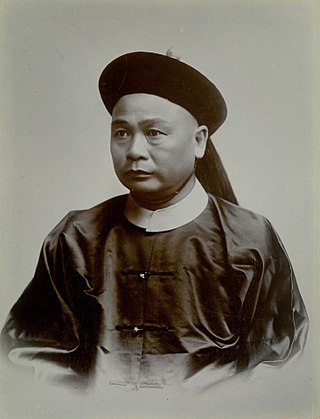
Zhan Tianyou, or Tien-Yow Jeme, was a pioneering Chinese railroad engineer. Educated in the United States, he was the chief engineer responsible for construction of the Peking-Kalgan Railway, the first railway constructed in China without foreign assistance. For his contributions to railroad engineering in China, Jeme is known as the "Father of China's Railroad".
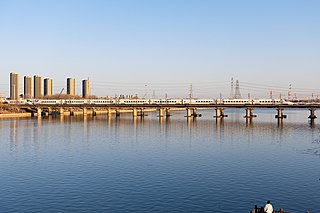
The Beijing–Harbin railway, or the Jingha Railway, is the railway that connects Beijing with Harbin, the capital of Heilongjiang Province. It spans 1,249 km (776 mi). It is a very prominent route in the provinces of northeastern China.

Southwest Jiaotong University is a national public science and engineering university in Chengdu, Sichuan, China. The university is affiliated with the Ministry of Education. It is a national key university co-sponsored by the Ministry of Education, China Railway Corporation, the Sichuan Provincial Government, and the Chengdu Municipal Government. The university is part of Project 211 and the Double First-Class Construction.
Rail transport in China began in the late nineteenth century during the Qing dynasty. Since then, the Chinese rail network has become one of the largest in the world.

The gauge for most of the China national railway network is standard gauge. Currently, in the national railway network, only the 1,000 mmmetre gauge Kunming–Haiphong railway uses narrow gauge. In addition, there are some industrial lines still using narrow gauge, mostly 2 ft 6 in narrow gauge or 600 mm narrow gauge. As of 2003, 600+ km narrow-gauge railways, 50000+ km standard gauge railways, and 9.4 km broad gauge railways were in use in mainland China.
The first 1,435 mmstandard gauge railway to be built and survive in China was the Kaiping (開平) colliery tramway located at Tangshan in Hebei province. However, this was not the very first railway in China. An earlier attempt to introduce railways had been made in 1876 when the short Shanghai to Wusong narrow gauge line known as the "Woosung Road Company" was built but then pulled up within less than two years because of Chinese government opposition.

Claude William Kinder, was an English engineer. For over thirty years he was engineer-in-chief of the Kaiping Tramway and Imperial Railways of North China.

Guye District is a district of the city of Tangshan, Hebei province, China. The district is located approximately 28 kilometres (17 mi) to the east of Tangshan's urban center. Guye District spans an area of 249 square kilometres (96 sq mi), and has a population of 358,461 per the 2010 Chinese Census.

Kaiping District is a district of Tangshan, Hebei, China. The district spans an area of 236 square kilometres (91 sq mi), as has a population of about 240,000 as of 2012.

Grant Locomotive Works was a manufacturer of steam railway locomotives from 1867 to 1895, first in Paterson, New Jersey, and then in Chicago. The company built about 1,888 locomotives.
Xugezhuang is a former village and modern town of Fengnan District in Hebei, China.
Lieutenant Colonel Arthur John Barry (1859-1943) was an English civil engineer and architect of the late 19th and early 20th century.

China Railways SY is a 2-8-2 Mikado locomotive operated by the China Railway. It was built mostly by Tangshan Locomotive and Rolling Stock Works between 1960 and 1999.
The Kaiping Mines was one of the first modern mining companies in Zhili, China. It was founded by Li Hongzhang and production began in 1881. During this period of the mines (1881-1912) at times the annual coal production reached 1,400,000 tons. One of the principals was Zhou Xuexi and the chief engineer was Herbert Hoover.
Rocket of China is a Chinese historical comedy set in nineteenth century China based on the true story of the history of the construction of Rocket of China, the first steam locomotive made in China, with the help of an English engineer Claude W. Kinder who in 1878 travelled to Qing Dynasty China in the hope of building the first railway through China. The 30 episode comedy was directed by Ying Da and written by Man Yu. Appearing in the comedy are Cao Yun Jin, Jiang Chao, Liu Jin Shan, Ma Ling, Yu Hui Zi, Li Jian Hua, Li Qi, Na Wei, Liu Ya Jin, Yan Guan, Qi Xiao Fei, Isabella Charlton, Karl Robert Eislen, Jonathan Kos-Read and among others. It was produced by Xui Ji Wei in the Production Company of Long Teng Yi Du (Beijing) Film Investment Co., Ltd. The comedy was first aired on Shenzhen Media Group Public Channel on 1 February 2016.
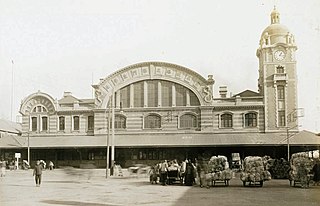
Peking–Mukden Railway was a 19th-century steam powered trunkline connecting Peking (Beijing) and Mukden through Tianjin, northeastern Hebei, and southwestern Liaoning; it was a crucial railway in North China and Northeast China.
Xiao Han was a Chinese politician and energy industry executive. He served as Minister of Coal Industry (1977–1980), Vice Director of the State Economic and Trade Commission, and Chairman of China Huaneng Group. He helped found the state-owned coal company Shenhua Group in 1995 and served as its first chairman until his retirement in 1998.

Sun Yueqi, formerly known as Sun Yuqi or Sun Shifen, was an industrialist and politician in the Republic of China and later the People's Republic of China. He led the surveys and developments of several coal mines and oil fields in China, such as the Yanchang and Yumen Oilfields.













